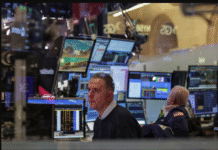
U.S. stocks ended the worst year since the financial crisis with a narrow gain in thin pre-holiday trading. Treasuries rose to a 10-month high.
The S&P 500 finished a choppy session higher and the Nasdaq Composite capped its first four-day advance since August amid optimism that President Donald Trump will move toward a trade deal with China. The advance trimmed the worst December rout for the S&P 500 since 1931 to 9.2 percent. That monthly rout capped a 6.2 percent slide in the year, the biggest of the record bull market.
Stocks around the world limped into the end of a dismal year that’s seen bear markets in equities from Japan to Germany. Europe’s main stock gauge fell 13 percent drop in the year — the biggest since 2008. The 10-year Treasury yield slid to 2.68 percent, the lowest since February. The dollar edged lower as a government shutdown continued, while the yen climbed to a four-month high.
In commodities, crude slumped to its first annual loss since 2015, completing a reversal that saw it drop from a four-year high set just three months ago. Natural gas futures slid on Friday below $3 for the first time since September, giving the front-month contract its worst December since 1991. Gold barreled into 2019 near a six-month high on haven demand.

While the glimmer of hope on the trade front sent global stocks out on a high note, plenty of event risks loom in the next 12 months, from the U.K.’s exit from the European Union to U.S.-China trade talks and the continuing showdown between President Trump and Congress over the budget. The American political landscape is also unsettling investors following departures of senior officials and Trump’s repeated criticism of Federal Reserve Chairman Jerome Powell.
Here’s how major markets performed this year:
- The S&P 500 fell 6.2%
- The Dow Jones Industrial Average slid 5.6%
- The Nasdaq Composite dropped 3.9%
- The Russell 2000 fell 12%
- The Stoxx Europe 600 declined 13%
- The MSCI Asia Pacific Index dropped 15%
- The MSCI Emerging Markets Index slid 16%
- Ten-year Treasury yields gained 28 basis points.
- The Bloomberg Dollar Spot Index advanced 3.2%
- The Japanese yen rose 2.8%
- The euro dropped 4.6%
- West Texas crude declined 25% to $45.41 a barrel
Here are some events investors may focus on in coming days:
- The U.S. December jobs report is due Friday, Jan. 4.
- Fed Chair Powell is interviewed with predecessors Janet Yellen and Ben Bernanke at the annual meeting of the American Economic Association Friday. Atlanta Fed President Raphael Bostic joins a panel on long-run macroeconomic performance.
And these are the main moves in markets Monday:
Stocks
- The S&P 500 Index rose 0.9 percent as of 4 p.m. New York time.
- The Nasdaq Composite added 0.8 percent. The Dow rose 265 points and the Russell 2000 gained 0.8 percent.
- The Stoxx Europe 600 Index rose 0.4 percent to the highest in more than a week.
- The MSCI All-Country World Index gained 0.3 percent to the highest in more than a week.
- The MSCI Emerging Market Index climbed 0.4 percent to the highest in more than a week.
Currencies
- The Bloomberg Dollar Spot Index dipped 0.2 percent to the lowest in almost 10 weeks.
- The euro added 0.1 percent to $1.1455.
- The Japanese yen rose 0.6 percent to 109.613 per dollar, the strongest in about six months.
Bonds
- The yield on 10-year Treasuries fell three basis points to 2.68 percent.
- The two-year yield lost three basis points to 2.49 percent.
Commodities
- The Bloomberg Commodity Index fell 1.1 percent.
- West Texas Intermediate crude rose 8 cents to $45.41 a barrel.
- U.S. natural gas futures slid 9.8 percent to $2.979.
- Gold futures rose 0.1 percent to $1,284.30 an ounce.


















Thank you for sharing all these stats.